Livestreaming has become a valuable and necessary part of small business operations. Whether you have an established business, you are just starting out or you are a freelancer, livestreaming is a great skill to have. From hosting webinars to streaming live events, or creating engaging content for your audience, the right livestream camera is key to achieving the best streaming experience.
This guide will consider the different factors and features when choosing the best live-streaming camera. This includes the types of cameras, their technical specifications, software and hardware requirements, and much more. The goal is to provide you with valuable information so you can be better informed when you are ready to make the decision to buy the best camera for streaming.
Types of Livestream Cameras
There are several types of cameras suitable for livestreaming, each with its own advantages and drawbacks. The main types include:
- Webcams: Affordable and easy to use, webcams are a popular choice for entry-level livestreaming. They offer plug-and-play functionality and decent video quality but may lack advanced features found in more professional cameras. Webcams can be connected to your computer via USB and are compatible with most livestreaming platforms. If you’re on a budget and need a simple solution for video calls or basic streaming, a webcam could be a viable option.
- DSLR and Mirrorless Cameras: These cameras offer excellent image quality and versatility, with interchangeable lenses and a range of manual settings to fine-tune your livestream. Mirrorless or DSLR cameras have larger sensors, allowing for better low-light performance and a shallower depth of field. They can also capture high-quality still images, making them a great all-in-one solution for content creators. However, they tend to be more expensive than webcams and may require additional accessories, such as capture cards, for livestreaming.
- Camcorders: Designed specifically for video recording, camcorders provide good video quality, long battery life, and ergonomic designs for handheld use. Some camcorders offer built-in livestreaming capabilities or can be connected to a computer via HDMI. While they may not have the same image quality as DSLRs or mirrorless cameras, camcorders are a solid choice for those who prioritize video features and ease of use.
- Action Cameras: Compact and rugged, action cameras are designed for capturing video in extreme conditions. While not specifically built for livestreaming, some action cameras, like the GoPro, have livestreaming capabilities via Wi-Fi or a dedicated app. These are the best streaming cameras suited for adventure sports, outdoor events, or any situation where a small, durable camera is required.
- PTZ (Pan-Tilt-Zoom) Cameras: Ideal for conference rooms, event venues, and larger spaces, PTZ cameras offer remote control over the camera’s movement and zoom. These cameras are typically more expensive but provide a professional, high-quality livestreaming solution with flexibility and ease of use.
The Best Livestream Cameras for Small Business Owners and Entrepreneurs
| Top Pick: Logitech Brio 4K Webcam | Runner Up: Sony ZV-1 Digital Camera | Best Value: Razer Kiyo Streaming Webcam | |
|---|---|---|---|
| Video Resolution | Ultra 4K HD | 4K | 720p 60 FPS / 1080p 30 FPS |
| Zoom | 5x HD zoom | 3x optical zoom | Not specified |
| Microphone | Dual omnidirectional mics | On-board mic | Not specified |
| Software | Sync device management | Not specified | Compatible with OBS, XSplit, Twitch, YouTube, Zoom, Microsoft Teams, Skype |
| Special Features | Windows Hello integration, privacy shade | Fast Hybrid Autofocus, Real-Time Eye Autofocus, side flip-out 3.0” LCD screen | Adjustable brightness, superior low-light performance, built-in ring light |
| Pros | High resolution, advanced features, suitable for remote teams | High-quality image and video capabilities, range of features for content creation | Full HD resolution, 60 fps streaming, built-in ring light |
| Cons | High price point, advanced features may not be needed by all users, tripod not included | Limited zoom, single slot memory, limited mic compatibility, no internal ND filters | Limited to USB connectivity, Micro SD memory, smaller screen size |
Logitech Brio 4K Webcam
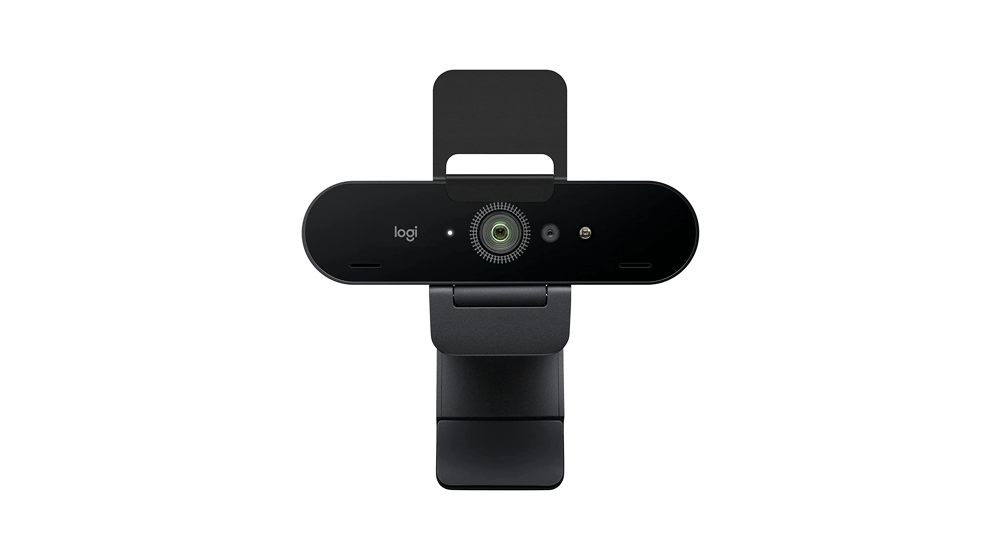
Top Pick: The Logitech BRIO is a top-of-the-line video camera that offers great video and audio quality to livestream and keep your team connected from anywhere. With ultra 4K HD resolution, 5x HD zoom, and the Logitech RightLight 3 HDR technology to adjust to any lighting situation, ensuring you always look your best. Plus, dual omnidirectional mics cancel out background noise, so you can be heard loud and clear.
Features:
- Sync device management software to keep your team connected no matter where they are
- Three field of view presets to choose from for more flexibility
- Windows Hello integration for secure and easy sign-in
- A privacy shade to keep your camera safe and secure
Pros:
- Ultra 4K HD resolution and 5x HD zoom
- Dual omnidirectional mics for noise-canceling
- Sync device management software for remote teams
- Windows Hello integration for secure and easy sign-in
Cons:
- High price point compared to other webcams
- Some users may not need all of the advanced features
- Tripod not included, which may be an additional expense
The Logitech BRIO is versatile and easy to use. With customizable pan, zoom, and image controls, you can personalize your video calls with ease. Plus, the adjustable clip makes it easy to mount the webcam wherever you need it. And with a 1-year limited hardware warranty, you can rest assured that you’re getting a quality product that will last.
Sony ZV-1 Digital Camera
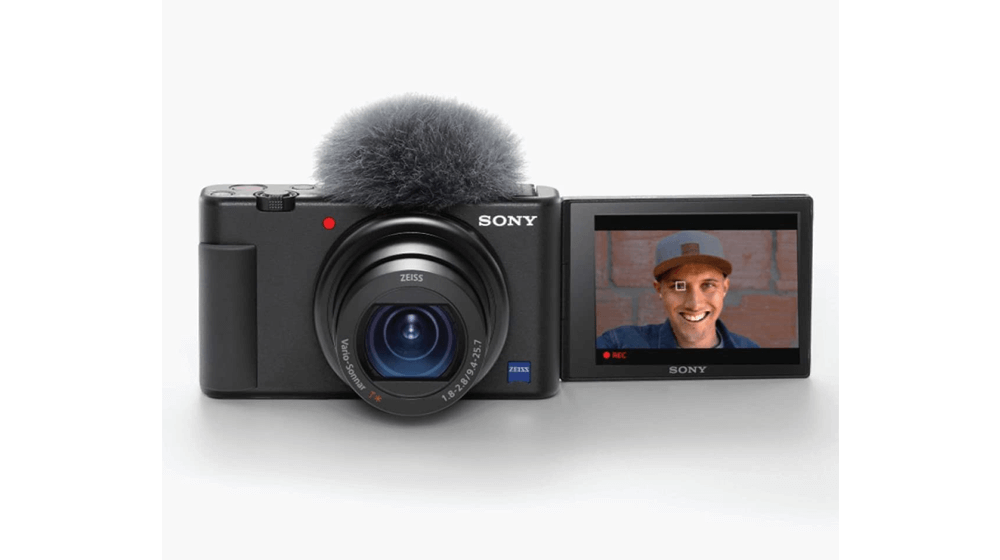
Runner Up: The Sony ZV-1 Camera for Content Creators and Vloggers is designed to deliver top-notch image quality and video capabilities for all your content creation needs.
Featuring a 20.1MP stacked back-illuminated 1” Exmor RS CMOS sensor with DRAM, and a large aperture 24-70mm F1.8-2.8 ZEISS Vario-Sonnar T lens, this camera delivers stunning image quality. Plus, with Fast Hybrid Autofocus and Real-Time Eye Autofocus, you can ensure that your subject is always in focus.
Features:
- A side flip-out 3.0” LCD screen that tilts up and down for easier selfie shots
- Two modes of defocused background bokeh for added creative flexibility
- Automatic exposure that tracks faces to ensure they are well-lit
- Forward-directional on-board mic and detachable windscreen for great sound quality
- Image stabilization to suppress camera shake, even when walking
- Optimized color with enhanced skin-tone reproduction
- Pro video functions like HLG (Hybrid Log-Gamma) and S-Log3/2
Pros:
- High-quality image and video capabilities
- Fast Hybrid Autofocus and Real-Time Eye Autofocus
- Range of features to make content creation easier
- Optimized color with enhanced skin-tone reproduction
Cons:
- No optical zoom beyond 3x
- Flash memory limited to single slot
- Limited compatibility with microphones beyond standard 3.5mm mic jack
- No internal ND filters for bright outdoor shooting
Overall, the Sony ZV-1 Camera for Content Creators and Vloggers is a great option for businesses looking to create high-quality content.
Razer Kiyo Streaming Webcam
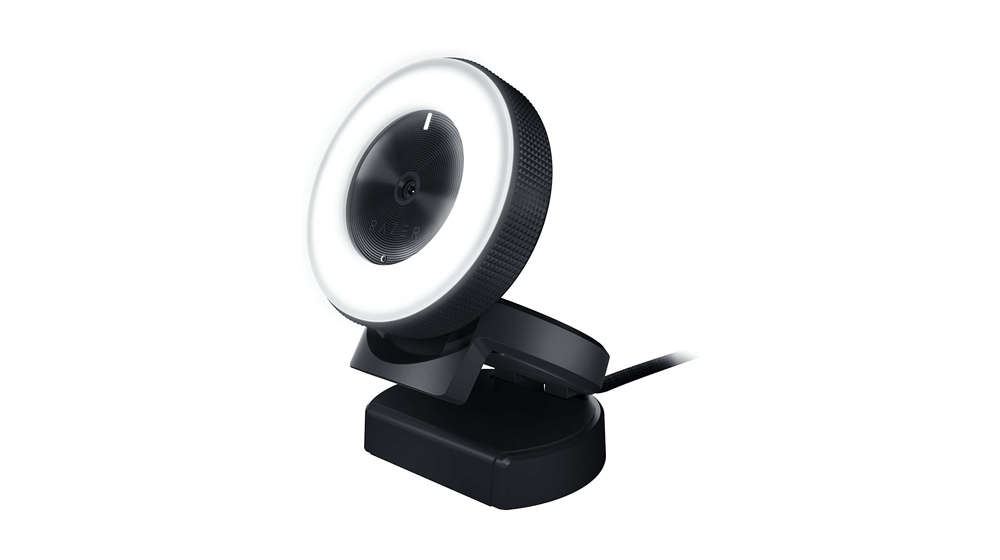
Best Value: The Razer Kiyo a powerful desktop camera features a multi-step ring light that you can adjust on command, and it can stream at 60 fps for maximum gaming fidelity.
With full HD video resolution at 720p 60 FPS / 1080p 30 FPS, the Razer Kiyo provides crisp, detailed video and audio recording that works great for streaming, gaming, recording, video calling, conferencing, and online school. Plus, the 5600K daylight-balanced ring light around the camera provides even lighting without the hassle of additional lighting equipment.
Features:
- Adjustable brightness that you can quickly adjust by rotating the built-in ring light
- Superior low-light performance that reduces graininess and brings out details in darker environments
- A compact, folding design that looks sleek on any gaming setup or office
- Compatibility with popular platforms like OBS, XSplit, Twitch, YouTube, Zoom, Microsoft Teams, and Skype
Pros:
- Full HD resolution and 60 fps streaming
- Built-in ring light for even lighting
- Adjustable brightness for quick adjustments
- Superior low-light performance
Cons:
- Limited to USB connectivity
- Flash memory limited to Micro SD
- Smaller 2-inch screen size may not be ideal for all users
Sony 4K HD Video Recording Camcorder
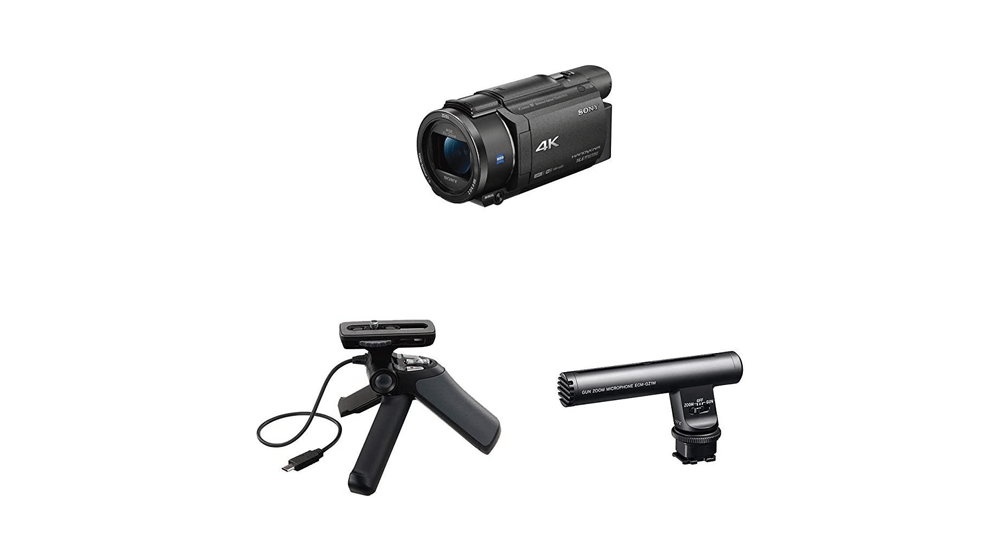
The Sony FDRAX53/B is an advanced action camera for businesses looking to capture high-quality footage on the go. With its 4K XAVC-S recording, 16.6MP Exmor R sensor, and B.O.SS stabilization, your footage will always be steady and clear.
Features:
- ZEISS lens with 20x optical zoom in 4K and 30x Clear Image Zoom in 4K for added flexibility
- Records in Zoom Mic and Gun mic modes for enhanced audio quality
- Zoom Mic Mode records audio level corresponding to zoom length for even better audio control
- Shooting grip with built-in tripod for added stability
- Designed for a comfortable fit for extended use
Pros:
- 4K video capture resolution for top-notch video quality
- ZEISS lens with 20x optical zoom in 4K and 30x Clear Image Zoom in 4K for added flexibility
- Shooting grip with built-in tripod for added stability
- Comfortable design for extended use
Cons:
- Limited flash memory options with only Memory Stick PRO DUO and SD compatibility
- Night vision and low light features may not be suitable for all users
- The position of the photo button may lead to accidental photos, and the manual power button is located behind the LCD screen, which may be inconvenient.
Sony 4K HD Video Recording Camcorder
Microsoft LifeCam HD-3000 for Business
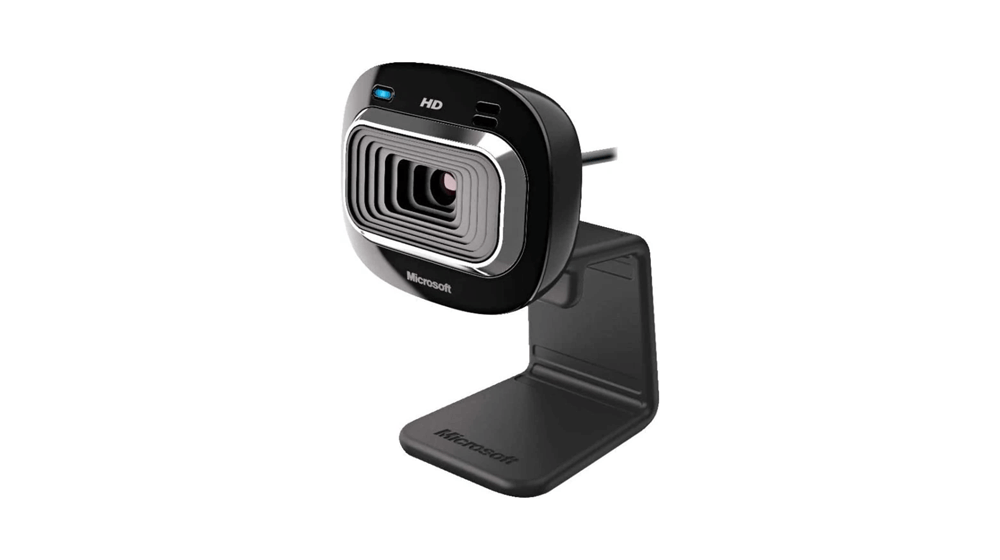
The Microsoft True 720p HD Camera delivers exceptional image quality and crystal-clear audio, making it an ideal tool for streaming, remote work, video conferencing, and social media content creation. Its universal attachment base makes it easy to use on desktops, laptops, and notebooks, and its noise-canceling microphone ensures that your audio is clear and easy to hear.
Features:
- True 720p HD Video: Produces bright and colorful video that can be easily shared on social media platforms
- 16:9 Widescreen: Provides a cinematic video recording experience
- Clear, High-Quality Video: Offers superior color and brightness even in low light conditions
- Noise Cancelling Microphone: Delivers crystal-clear audio with a built-in unidirectional microphone and acoustic noise cancellation
- Universal Attachment Base: Makes it easy to use on any device
Pros:
- Superior color and brightness in low light conditions
- Easy to attach to any device
- Provides a cinematic video recording experience
- Crystal-clear audio with noise cancellation
Cons:
- Limited to 720p resolution
- No optical zoom
- No pan/tilt functionality
Microsoft LifeCam HD-3000 for Business
GoPro HERO10 Black – Waterproof Action Camera
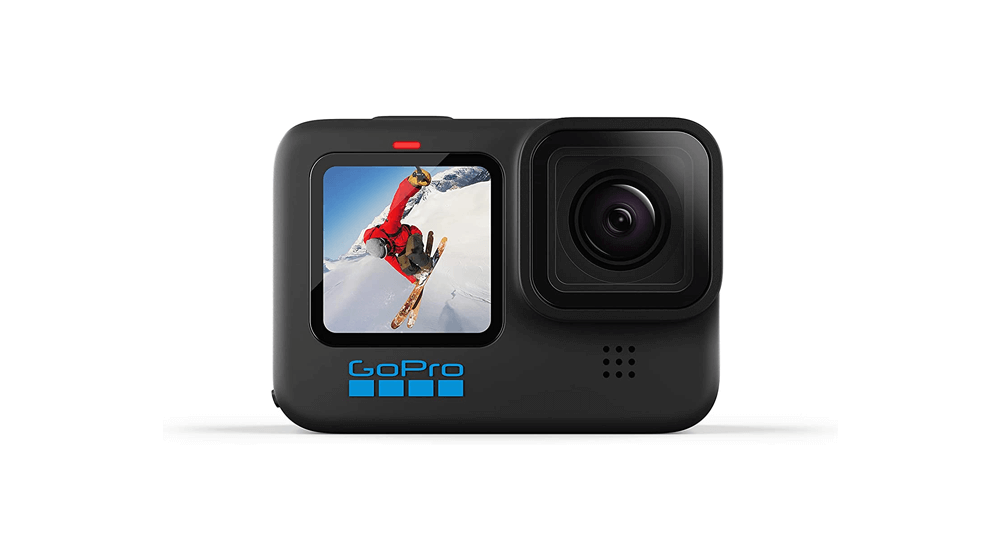
The HERO10 Black by GoPro is a powerful action camera. Its new GP2 chip offers double the frame rate of the HERO9 Black, 23MP photos, and enhanced low-light performance. You can capture 5.3K video at 60fps with clarity and smooth motion, and enjoy 8x slo-mo at 2.7K.
The camera features HyperSmooth 4.0 stabilization for even better low-light performance and horizon leveling with a higher tilt limit, so your footage looks perfectly straight. Additionally, the camera is waterproof to depths of 33ft and comes with a large-capacity, 1720mAh lithium-ion rechargeable battery for extended use.
Features:
- Revolutionary GP2 chip for double the frame rate and enhanced performance
- 23MP photos and 5.3K video resolution at 60fps
- HyperSmooth 4.0 stabilization for excellent low-light performance and horizon leveling
- Waterproof to 33ft
- Large-capacity, 1720mAh lithium-ion rechargeable battery for extended use
- Front LCD screen for improved framing of vlogging and selfies
- Power Tools, including LiveBurst and HindSight modes
- Versatile webcam and live streaming functionality
Pros:
- Improved performance with GP2 chip and HyperSmooth 4.0 stabilization
- High-quality front LCD screen and touch controls for responsive shutter
- Long-lasting battery
- Versatile webcam and live streaming functionality
Cons:
- Small sensor
- Low-light is still an issue
- A bit more expensive than last year’s flagship
- Not great battery life
GoPro HERO10 Black – Waterproof Action Camera
Elgato Facecam – True Full HD Webcam for Live Streaming
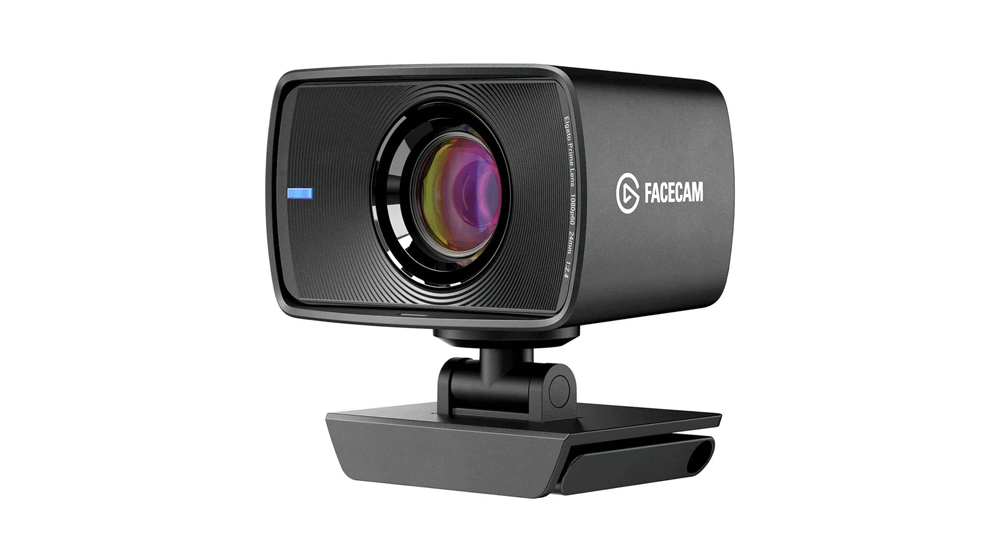
The Elgato’s Facecam is a professional-grade webcam for your online content creation needs. This high-quality video camera offers a range of features that make it an ideal choice for anyone looking to up their video game. Here’s what you can expect:
Features:
- Elgato Prime Lens: f/2.4 24 mm* all-glass studio quality optics
- Sony STARVIS CMOS Sensor: optimized for indoor use
- Advanced Image Engine: uncompressed video without artifacts
- True Full HD: stunning 1080p resolution at a fluid sixty frames per second
- High-Speed Circuitry: USB 3.0 interface transfers image data with the lowest latency
- App control and onboard memory to recall image settings on all your computers
- Up to 82-degree field of view
- Fixed focus range ensures that you always stay in crystal-clear focus
Pros:
- Professional-grade lens and image sensor for exceptional video quality
- Uncompressed 1080p60 video output without artifacts
- Optimized for indoor use with minimal noise
- App control and onboard memory make it easy to use across multiple computers
Cons:
- Limited compatibility: The Elgato Facecam is only compatible with Windows 10 (64-bit) and macOS 11.0, which may not work for everyone.
- No built-in microphone: While the Elgato Facecam offers exceptional video quality, it doesn’t come with a built-in microphone. This means you’ll need to purchase a separate microphone if you want high-quality audio to match your video.
- Inaccurate color representation, especially with purples
- Lack of adjustable focus can make extreme close-ups challenging
Elgato Facecam – True Full HD Webcam for Live Streaming
EMEET 4K Ultra HD 60FPS Webcam for Streaming
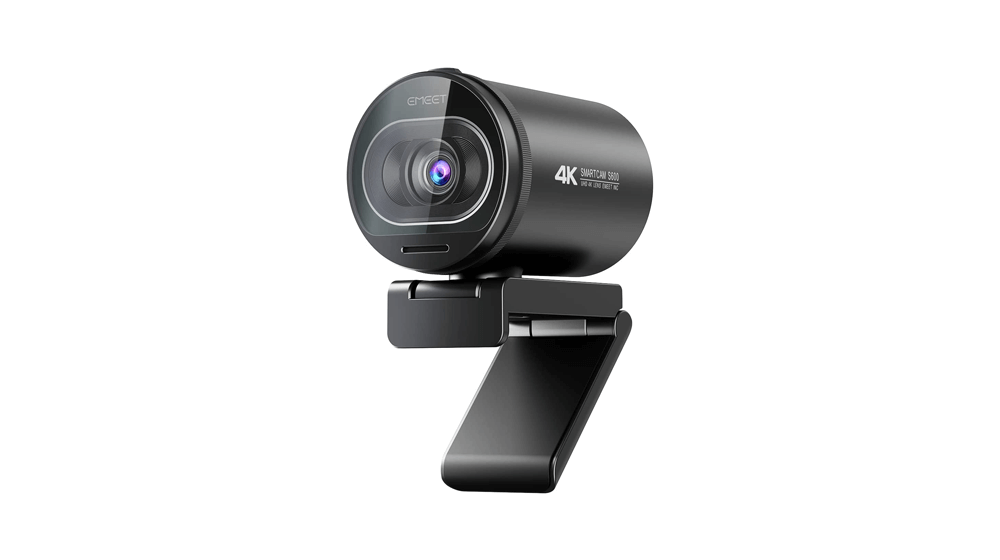
The EMEET S600 streaming camera boasts a 4K UHD sensor, delivering higher-quality visuals than a typical webcam. Its 60fps capability gives you smoother video streaming than the standard 30fps. This is great for live-streaming because it ensures no lag during broadcasts, by capturing every moment.
Features:
- 4K UHD sensor for ultimate image quality
- 1080P 60FPS for a smooth video experience
- Dual noise-canceling mics and 88° wide-angle lens
- Autofocus and auto light balance for fine-grained control
- Rotatable privacy cover to protect your privacy
- Plug and play, strong compatibility
Pros:
- Provides high-quality images and videos
- Dual noise-canceling mics automatically filter out background noise
- Autofocus and auto light balance make it easier to adjust to different lighting situations
- Rotatable privacy cover ensures your privacy is protected
Cons:
- It might be too large and heavy for some users
- The privacy cover is just a physical cover and does not offer any additional security features.
EMEET 4K Ultra HD 60FPS Webcam for Streaming
Canon PowerShot Vlogging 4K Video Streaming Camera
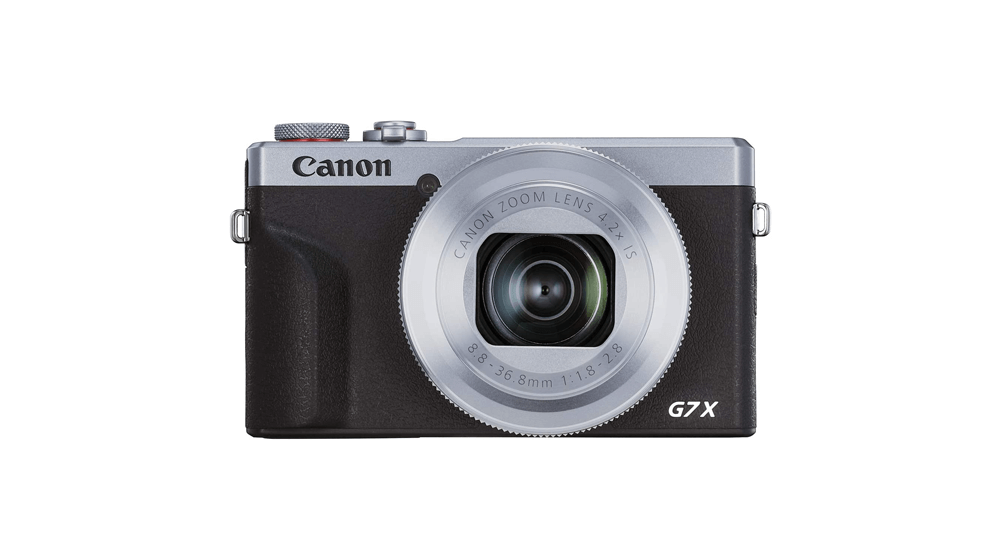
The Canon Digital Video Camera is a sleek point-and-shoot model that features a versatile optical zoom lens (24-100mm f/1.8-2.8) with optical image stabilization, so you can get close to your subjects while maintaining image clarity.
Features:
- 20.1 MP effective still resolution
- 4.2x optical zoom lens (24-100mm f/1.8-2.8) with optical image stabilizer
- 4K 30P/FHD 120P video
- Panorama mode for capturing wide landscapes
- Wi-Fi and NFC connectivity for easy sharing and transfer of images
- 3-inch screen size for easy viewing
- 1-inch photo sensor size for professional-grade image quality
Pros:
- High-quality images and videos with excellent clarity and detail
- Wi-Fi and NFC connectivity for easy sharing and transfer of files
- Panorama mode for capturing wide landscapes
- 4.2x optical zoom lens with optical image stabilizer for sharp, steady shots
Cons:
- Limited dynamic range in bright areas
- The custom ring on the lens cannot be mapped to focusing
- Higher cost compared to entry-level cameras
- No built-in flash
Canon PowerShot Vlogging 4K Video Streaming Camera
Panasonic Full HD Camcorder
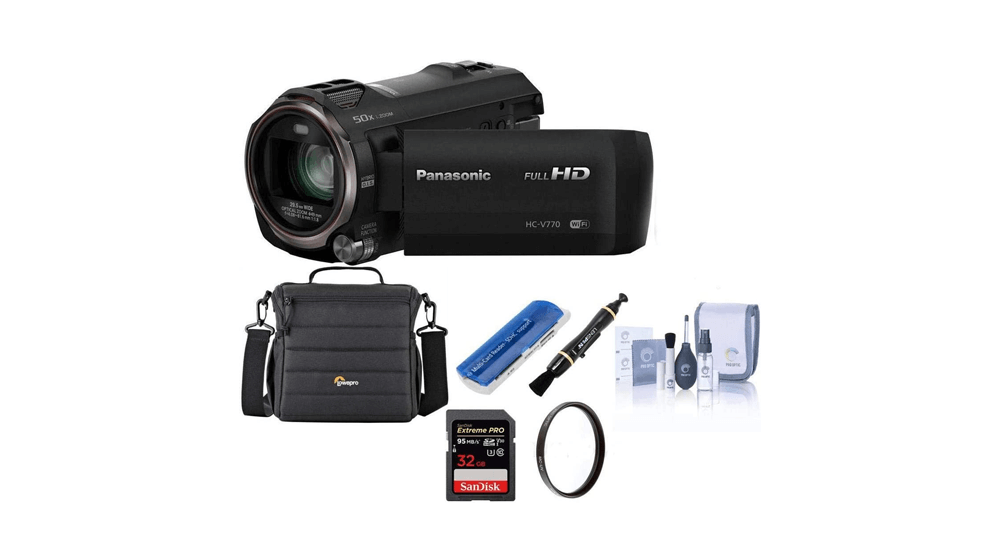
The Panasonic HC-VX981K 4K Ultra HD Camcorder is a great successor to its predecessor, the HC-VX870. While it does offer many of the same features as its predecessor, such as sharp HD and 4K quality videos, improved form factor, sensors, lenses, and manual controls, it also includes some necessary improvements and new features to make it a worthy upgrade. Here are some of its key features:
Features:
- 18.91 Megapixel MOS sensor plus 20x Zoom LEICA Decomar Lens
- 5-axis Hybrid O.I.S. for optical image stabilization
- 1/2.3-Inch BSI Sensor for better shooting in dimly lit conditions
- Ultra-sharp 4K Ultra HD recording
- In-camera editing for 1080p displays
- HDR Movie Feature to suppress blown highlights and blocked shadows
- Wireless Twin Camera for picture-in-picture video effect
Pros:
- Offers high-quality images and videos
- Optical image stabilization ensures steady footage
- HDR movie feature helps to create crisper and clearer videos
- Wireless twin camera allows for added creative options
Cons:
- Does not come with a physical remote or LANC jack, requiring the use of the wireless link to a cell phone for remote use, which can be laggy
- The sensor is similar to that used in the HC-VX870 with limited improvements
- Battery life could be better, especially with 4K video recording in mind
- The wireless link can be slow, which may impact its usefulness for recording sports.
Factors to Consider When Choosing a Livestream Camera
Video Quality
One of the most important factors to consider when choosing a livestream camera is the video quality it offers. High-definition (HD) resolution is essential for creating professional-looking livestreams. Look for cameras with a minimum of 1080p resolution, although 4K resolution is becoming increasingly popular for its exceptional image quality. Keep in mind that higher resolutions require more bandwidth and a faster internet connection for smooth streaming.
Low-Light Performance
Livestreaming often takes place in low-light environments, such as indoor events or during evening hours. A camera’s low-light performance is determined by its sensor size and ISO range. Larger sensors and higher ISO values allow the camera to capture more light, resulting in better video quality in low-light situations. DSLR and mirrorless cameras typically perform better in low light than webcams or camcorders, thanks to their larger sensors.
Autofocus and Image Stabilization
Fast and accurate autofocus is essential for maintaining sharp, clear video during livestreams, especially when there’s movement in the frame. Look for cameras with reliable autofocus systems that can quickly and smoothly adjust focus as the scene changes.
Image stabilization is another important feature, particularly for handheld live streaming or when using longer lenses. Optical image stabilization (OIS) is generally more effective than digital image stabilization, as it compensates for camera shake directly within the lens.
Audio Quality
While video quality is crucial, don’t overlook the importance of audio quality in your livestreams. Built-in microphones on most cameras are often insufficient for capturing clear, professional audio. Look for cameras with external microphone inputs, which allow you to connect higher-quality microphones for better audio capture. Some cameras also offer advanced audio features, such as noise reduction or audio level controls.
Connectivity and Compatibility
Your livestream camera should be easy to connect to your computer or streaming platform. Many cameras offer USB or HDMI connectivity, while some even have built-in Wi-Fi for wireless streaming. Make sure the camera you choose is compatible with your preferred streaming software and hardware, such as capture cards or switchers, if necessary.
Battery Life and Power Options
Long battery life is important for livestreaming events or sessions that last several hours. Some cameras have removable batteries, allowing you to swap them out for fresh ones as needed. Others offer continuous power options, such as AC adapters or external battery packs, which can provide uninterrupted power for extended livestreams.
Price and Budget
Finally, consider your budget when choosing a livestream camera. There is a wide range of options available, from affordable webcams to high-end professional cameras. Determine your priorities and the features you need most, and find a camera that offers the best value within your budget.
Livestream Camera Accessories
Tripods and Mounts
A sturdy tripod or mount is essential for keeping your camera steady during livestreams. Look for tripods with adjustable heights and fluid heads for smooth pan and tilt movements. For webcams, consider using a clamp or suction cup mount to attach the camera to your computer monitor or other surfaces.
External Microphones
As mentioned earlier, an external microphone can greatly improve the audio quality of your livestreams. There are several types of microphones available, such as lavalier, shotgun, or condenser microphones, each with their own advantages and best-use scenarios. Choose a microphone that suits your livestreaming needs and offers the best audio quality within your budget.
Lighting
Good lighting is essential for creating professional-looking livestreams. Invest in a basic lighting kit, such as softboxes or LED panels, to ensure your subject is well-lit and eliminate harsh shadows. For smaller setups or on-the-go livestreaming, consider using portable LED lights or even a built-in ring light on your camera or webcam.
Capture Cards and Switchers
For streaming with DSLR or mirrorless cameras, you may need a capture card to convert the camera’s HDMI output into a format compatible with your computer or streaming platform. Some capture cards also offer additional features, such as multi-camera switching or streaming overlays.
If you plan to use multiple cameras during your livestream, consider investing in a video switcher to seamlessly switch between camera feeds.
Editing and Post-production Software
For a polished and professional-looking livestream, consider using editing and post-production software. These tools allow you to add overlays, animations, and other visual effects to enhance your livestream. Popular livestream editing software includes OBS Studio, vMix, and Wirecast.
Some streaming platforms, such as Twitch and YouTube, also offer built-in editing tools for creating a polished final product.
Networking and Connectivity
A stable and fast internet connection is essential for smooth and high-quality livestreams. For the best results, use a wired Ethernet connection rather than relying on Wi-Fi, as this provides a more stable and faster connection. If you must use Wi-Fi, ensure that your router is updated and positioned close to your streaming setup to minimize interference and signal dropouts.
Sound and Acoustics
In addition to investing in a high-quality microphone, consider the acoustics of your streaming space. Hard surfaces and large rooms can cause echoes and other audio issues that detract from the overall quality of your livestream.
Adding soft furnishings, such as curtains or rugs, or using acoustic foam panels can help improve the sound quality in your streaming environment.
Backdrops and Set Design
The visual appeal of your livestream set can greatly impact viewer engagement. Use a clean and uncluttered backdrop, and consider incorporating branding elements or themed decorations relevant to your content.
A green screen can also be used to create custom backgrounds and virtual sets, adding a professional touch to your livestream.
Camera Lenses and Accessories
Depending on your camera and streaming requirements, investing in additional lenses and accessories can help improve the quality and versatility of your livestreams. For example, a wide-angle lens can capture more of your streaming space, while a macro lens can be used for detailed close-ups.
Additional accessories, such as a gimbal for smooth camera movement or an external monitor for easier framing, can also enhance your livestream production.
Monitoring and Viewer Interaction
Engaging with your audience is key to a successful livestream. Use a separate device, such as a tablet or smartphone, to monitor your livestream and interact with viewers through chat or social media. Responding to viewer comments and questions in real-time helps build a sense of community and encourages viewer retention.
Streaming Software and Platforms
Choosing the right streaming software and platform for your content is crucial. Popular livestreaming platforms include YouTube, Twitch, and Facebook Live.
Each platform has its own unique features and audience demographics, so consider which platform best aligns with your content and target audience. Additionally, choose streaming software that supports your chosen platform and offers the features you require for your livestream production.
Legal and Copyright Considerations
When livestreaming, it’s essential to be aware of and adhere to copyright and legal guidelines. This includes respecting the intellectual property of others, such as music, video clips, and images. Obtain permission or use royalty-free materials to avoid potential legal issues and maintain a professional reputation.
Choosing the Right Streaming Software and Hardware
Selecting the appropriate streaming software and hardware is crucial for a seamless livestreaming experience. Popular streaming software options include OBS, Wirecast, and vMix, each offering unique features and capabilities. When choosing software, consider system requirements and compatibility to ensure smooth operation on your device.
Hardware encoders can offer advantages, such as reduced CPU usage and dedicated encoding capabilities, improving overall streaming performance. Assess your needs and budget when making a decision on software and hardware to find the right combination for your livestreams.
Streaming Protocols and Encoding
Understanding streaming protocols and encoding techniques can help you deliver a high-quality livestream. Common streaming protocols include RTMP, HLS, and MPEG-DASH, which enable efficient content delivery over the internet. Video codecs, such as H.264, H.265, VP9, and AV1, compress video data to reduce bandwidth usage, while audio codecs like AAC, Opus, and MP3 handle audio compression.
Adaptive bitrate streaming adjusts video quality in real time based on viewer’s internet speed, providing an optimal viewing experience. Choose the right combination of protocols and codecs for the best streaming experience.
Internet Connection and Bandwidth Requirements
A stable internet connection and sufficient bandwidth are vital for a smooth livestream. Wired connections often provide faster and more stable connections than wireless alternatives. Bandwidth requirements vary depending on the resolution and bitrate of your livestream.
Higher resolutions and bitrates require more upload speed to maintain a consistent stream quality. Testing and troubleshooting your internet connection before starting a livestream can help avoid disruptions during your broadcast. Ensure you have a reliable internet connection to provide the best experience for your viewers.
Livestream Monetization Strategies
Monetizing your livestreams can provide an additional revenue stream. Ad revenue from pre-roll, mid-roll, and display ads can generate income based on viewer engagement. Sponsored content and brand partnerships offer opportunities for collaboration and financial support.
Pay-per-view and subscription models can create recurring revenue streams, while donations and crowdfunding enable direct support from viewers. Merchandise sales and affiliate marketing provide additional avenues for monetization. Experiment with different strategies to find the best fit for your content and audience.
Building and Growing a Livestream Audience
Attracting and retaining viewers is crucial for a successful livestream. Promote your livestream through social media and email marketing to reach a wider audience. Scheduling and consistency help establish a routine for viewers, increasing engagement.
Collaborations and cross-promotions with other creators can introduce your content to new audiences. Interacting with viewers and fostering a community creates loyalty and encourages return visits. Analyze viewer data and feedback to improve your content and grow your audience over time.
Livestreaming Gear and Accessories
Investing in quality gear and accessories can enhance your livestream production. Tripods and camera mounts provide stability and optimal framing, while lighting equipment ensures proper illumination for a professional look.
External microphones and audio interfaces improve audio quality, and green screens and backdrops allow for versatile background options. Stream decks and control surfaces enable efficient control of your livestream’s elements. Choose gear and accessories that fit your budget and production needs.
Connectivity and Streaming Software
When it comes to livestreaming, having a stable and high-speed internet connection is crucial to ensure smooth streaming and minimal buffering for your viewers. Here are some tips to achieve this:
- Wired vs. wireless connection: Opt for a wired Ethernet connection whenever possible, as it provides a more stable and faster connection than Wi-Fi.
- Minimum upload speed: Ensure your internet connection has an adequate upload speed for the desired streaming quality. For example, a 1080p livestream typically requires a minimum upload speed of 5 Mbps.
- Test your connection: Perform regular speed tests to monitor your internet connection and ensure it meets the requirements for livestreaming.
- Streaming software: Choose the right streaming software, such as OBS Studio, Streamlabs OBS, or vMix, that suits your needs and technical abilities. These programs help encode your video, manage your scenes and overlays, and send your livestream to your chosen platform.
Live Streaming with Mobile Devices and Accessories
Mobile devices can be used for livestreaming, but consider the pros and cons:
- Pros and cons of using smartphones and tablets for live streaming: Mobile devices offer convenience and portability but may lack dedicated cameras’ image quality and stability. Additionally, battery life and data usage can be limiting factors.
- Mobile apps for livestreaming: Explore different mobile apps designed for livestreaming, such as Streamlabs or Switcher Studio, to enhance your mobile streaming capabilities with additional features and tools.
- External lenses for mobile devices: Invest in external lenses, such as wide-angle, telephoto, or macro lenses, to improve the image quality and versatility of your mobile device’s camera.
- Mobile device stabilization options (gimbals, tripods): Use gimbals or tripods specifically designed for mobile devices to stabilize your livestream footage and achieve a more professional look.
- External microphones and audio accessories for mobile devices: Improve your livestream’s audio quality by using external microphones or audio interfaces compatible with your mobile device. This can greatly enhance the viewer’s experience and overall production value.
Backup and Redundancy Solutions
As with any live event, it’s essential to have backup solutions in place to minimize the risk of technical difficulties and disruptions to your livestream:
- Backup internet connection: Have a secondary internet connection available, such as a mobile hotspot, to quickly switch in case your primary connection fails.
- Power supply backup: Use an uninterruptible power supply (UPS) to protect your equipment from power surges and provide temporary power in case of an outage.
- Redundant streaming equipment: Keep extra cables, adapters, and even a spare camera or microphone on hand to quickly replace any malfunctioning gear during a livestream.
- Fail-safe streaming setup: Configure your streaming software to automatically switch to a backup video or graphic if your primary video source encounters issues, helping to maintain a professional appearance and minimize interruptions.
Camera Sensor Size and Performance
The sensor size of a camera plays a critical role in determining image quality and overall performance. There are several common sensor sizes you’ll encounter:
- Full-frame sensor: These sensors are typically found in high-end DSLR and mirrorless cameras. They deliver excellent low-light performance, a shallow depth of field, and superior image quality.
- APS-C sensor: A smaller sensor commonly used in mid-range DSLR and mirrorless cameras, APS-C sensors offer a balance between size, cost, and image quality, making them suitable for various types of livestreaming.
- Micro Four Thirds sensor: These sensors are used in many compact mirrorless cameras. While smaller than full-frame and APS-C sensors, they still provide good image quality and perform well in low-light conditions.
- 1-inch sensor: Found in high-quality compact cameras, 1-inch sensors produce sharp images and decent low-light performance, though not as good as larger sensors.
Comparing these sensor sizes will help you understand their impact on livestreaming, such as low-light performance, depth of field, and overall image quality.
Lens Options for Livestream Cameras
Choosing the right lens can greatly affect your livestream’s visuals. Consider the following options:
- Fixed vs. interchangeable lenses: Fixed-lens cameras have a built-in lens, while interchangeable-lens cameras allow you to swap out lenses. Interchangeable-lens cameras provide more flexibility and better image quality, but fixed-lens cameras are more affordable and portable.
- Zoom lenses: These lenses offer variable focal lengths, allowing you to adjust the field of view during your livestream. They are versatile but may not provide the sharpest image quality.
- Prime lenses: Prime lenses have a fixed focal length, meaning you cannot zoom in or out. However, they usually offer superior image quality and better low-light performance than zoom lenses.
- Wide-angle lenses: These lenses provide a wider field of view, which can be useful for capturing large scenes or small spaces. Keep in mind that wide-angle lenses may distort the image at the edges.
Focal length and field of view considerations should also be taken into account when selecting a lens for livestreaming. The right lens can improve image quality, depth of field, and overall viewer experience.
Camera Settings for Livestreaming
Proper camera settings ensure optimal livestream quality. Adjust the following settings as needed:
- Exposure settings (ISO, shutter speed, aperture): Exposure settings control the amount of light captured by the camera sensor. Adjust ISO, shutter speed, and aperture to achieve the desired brightness and depth of field for your livestream.
- White balance: White balance helps maintain accurate color representation in your video. Choose the appropriate setting based on your lighting conditions, or use a custom white balance for the most accurate results.
- Focus modes (manual vs. autofocus): Depending on the subject and type of livestream, you may prefer manual focus for quick adjustments. Consider your camera’s autofocus performance and the nature of your livestream when choosing a focus mode.
- File formats and compression: Choose the right file format and compression settings for your livestream to balance video quality and file size. Some platforms may have specific requirements or limitations, so be sure to research the best options for your needs.
Multi-camera Livestreaming Setup
A multi-camera setup can elevate your livestream production value. To set up multiple cameras, consider using:
- Switchers and mixers: Switchers and mixers allow you to seamlessly transition between multiple camera angles and inputs during your livestream, providing a more professional and dynamic viewing experience.
- Synchronizing multiple cameras: Ensure that all cameras are properly synchronized in terms of timecodes, frame rates, and settings to maintain a consistent look and feel throughout your livestream.
- Benefits and challenges of multi-camera livestreaming: While multi-camera setups can greatly enhance production value, they also require more planning, coordination, and equipment. Be prepared to manage the increased complexity and potential troubleshooting involved in multi-camera livestreaming.
Livestreaming for Different Business Types
Different businesses can benefit from livestreaming in various ways:
- Retail businesses: Livestreaming allows retail businesses to showcase their products, offer live demonstrations, and engage with potential customers in real-time. This can help increase sales and customer loyalty.
- Service-based businesses: Service-based businesses can use livestreaming to provide valuable information, answer questions, and demonstrate their expertise to potential clients. This can lead to increased trust and client acquisition.
- Online courses and workshops: Livestreaming enables educators to deliver interactive, real-time instruction to students around the world. This can expand the reach of their courses and provide a more engaging learning experience.
- Live events and performances: Livestreaming concerts, plays, and other events can bring the experience to a wider audience and create additional revenue streams through ticket sales or donations.
- Fitness and wellness classes: Livestreaming fitness classes or wellness workshops can help instructors reach a larger audience, provide real-time guidance and motivation, and create a sense of community among participants.
Livestreaming for Different Social Media Platforms
Each social media platform has its own best practices and features:
- Best practices for Facebook Live: Use a descriptive title, schedule your livestream in advance, and engage with viewers through comments and reactions. Monitor your stream’s performance using Facebook’s built-in analytics tools.
- Best practices for Instagram Live: Promote your livestream ahead of time, use Instagram’s “Live” sticker to alert followers, and engage with viewers through comments and questions. Save the livestream to IGTV for future viewing.
- Best practices for YouTube Live: Optimize your video title, description, and tags for searchability. Schedule your livestream in advance, and use YouTube’s live chat feature to interact with viewers. Monitor your stream’s performance with YouTube’s built-in analytics.
- Best practices for Twitch: Choose the appropriate category for your stream, use an engaging title, and customize your channel with graphics and overlays. Interact with viewers through chat, and consider using Twitch’s built-in monetization features to generate income.
Video Editing and Post-production for Livestreams
Enhance your livestreams with video editing and post-production techniques:
- Basic video editing techniques: Trim, cut, and arrange your video clips to create a polished final product. Adjust color, exposure, and audio levels for a professional look and sound.
- Adding graphics and overlays: Use graphics, text overlays, and lower thirds to provide additional information and context during your livestream. This can help make your content more engaging and informative.
- Repurposing livestream content for other platforms: Edit and repackage your livestream recordings for use on other platforms, such as shorter clips for social media or longer-form content for YouTube or podcasts.
- Archiving and organizing livestream recordings: Save and organize your livestream recordings for future reference, repurposing, or legal purposes. Consider using cloud storage or external hard drives for long-term storage.
Livestreaming Tips and Best Practices
To achieve a successful livestream, follow these tips and best practices:
- Camera positioning and framing: Properly position and frame your camera to capture the most important elements of your scene. Use the rule of thirds, leading lines, and depth to create visually appealing compositions.
- Audio quality and microphone placement: Good audio quality is crucial for an engaging livestream. Use a high-quality microphone, and place it close to the sound source while minimizing background noise.
- Lighting tips: Ensure your subject is well-lit by using natural light, softboxes, or LED panels. Avoid harsh shadows and overexposed areas to maintain a professional look.
- Background and environment considerations: Choose a clean, uncluttered background that complements your subject and minimizes distractions. Consider using a green screen for added flexibility in post-production.
- Engaging with the audience: Encourage viewer interaction by responding to comments and questions during the livestream. This helps foster a sense of community and keeps viewers engaged.
Ongoing Maintenance and Upgrades
To keep your livestreaming setup performing optimally, it’s important to perform regular maintenance and consider upgrades as needed:
- Clean and inspect equipment: Regularly clean your camera, lenses, and accessories, and check for any signs of wear or damage.
- Update software and firmware: Stay up-to-date with the latest software and firmware updates for your camera, streaming software, and other equipment to ensure compatibility and access to new features.
- Evaluate performance: Periodically assess your livestream’s performance by reviewing viewer feedback, analytics, and your own observations. Use this information to identify areas for improvement and potential upgrades to enhance your setup.
- Invest in future-proofing: When upgrading or purchasing new equipment, consider investing in gear that will remain relevant and useful as technology and livestreaming platforms continue to evolve.
Legal and Ethical Considerations for Livestreaming
Adhere to legal and ethical guidelines when livestreaming:
- Copyright and intellectual property: Ensure that you have the necessary rights and permissions to use any copyrighted material in your livestream, such as music, video clips, or images.
- Privacy concerns: Be mindful of privacy concerns when livestreaming, especially in public spaces or when featuring private individuals. Obtain consent from those featured in your livestream whenever possible.
- Accessibility requirements: Consider providing closed captions, transcripts, or other accessibility features to make your livestream more inclusive for viewers with disabilities.
- Platform-specific guidelines and restrictions: Familiarize yourself with the guidelines and restrictions of the platforms you use for livestreaming, and adhere to their rules to avoid potential penalties or bans.
- Handling negative comments and trolls: Manage and moderate your livestream’s chat and comments to maintain a positive environment for viewers. Address negative comments or trolls professionally, and consider using platform-specific tools or moderators to help manage the chat.
FAQ
What is the difference between a livestream camera and a regular video camera?
A livestream camera is specifically designed for capturing and streaming live video, while a regular video camera is primarily intended for recording video to be edited and viewed later. However, many modern video cameras also have livestreaming capabilities, making them suitable for both purposes.
Can I use my smartphone for livestreaming?
Yes, you can use your smartphone for livestreaming, but the video and audio quality may not be as good as with a dedicated livestream camera. Additionally, using a smartphone for extended periods may drain the battery quickly and potentially overheat the device.
Do I need a fast internet connection for livestreaming?
A fast and stable internet connection is essential for smooth livestreaming, especially at higher video resolutions. For 1080p streaming, a minimum upload speed of 5 Mbps is recommended, while 4K streaming requires at least 25 Mbps.
How important is audio quality in livestreaming?
Audio quality is just as important as video quality in livestreaming, as clear and professional-sounding audio helps keep viewers engaged and provides a better overall experience. Investing in a high-quality external microphone can greatly improve the audio quality of your livestreams.
Can I use a DSLR or mirrorless camera for livestreaming?
Yes, many DSLR and mirrorless cameras can be used for livestreaming, provided they have clean HDMI output and are compatible with your streaming software or hardware. Keep in mind that some cameras may require a capture card to convert the HDMI signal for streaming.
What additional equipment do I need for a professional livestream setup?
In addition to a camera, you may need a tripod or mount, external microphone, lighting, capture card, and possibly a video switcher for a professional livestream setup. Investing in quality equipment will help ensure your livestreams look and sound professional.
Can I use an action camera for livestreaming?
Some action cameras, such as GoPro models, offer livestreaming capabilities. However, the video and audio quality may not be as good as with dedicated livestream cameras or DSLR/mirrorless cameras. Action cameras can be a suitable option for unique or action-packed livestreams where a compact, rugged camera is necessary.
Image: Amazon
This article, “Livestream Camera: Top-Rated Picks for High-Definition Business Streaming” was first published on Small Business Trends